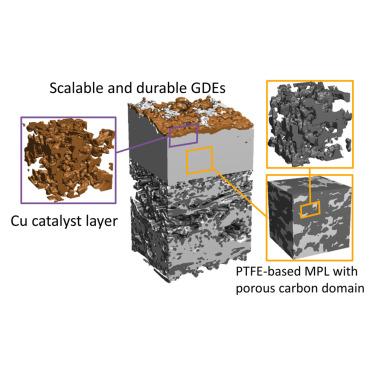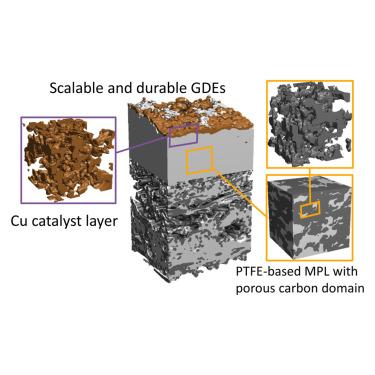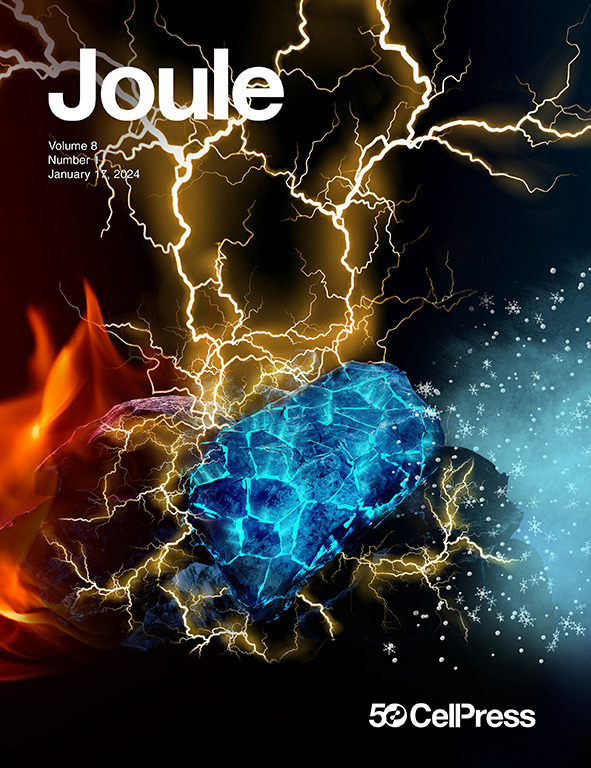Scalability and stability in CO2 reduction via tomography-guided system design
IF 38.6
1区 材料科学
Q1 CHEMISTRY, PHYSICAL
引用次数: 0
Abstract
Electrocatalytic CO2 reduction offers a means to produce value-added multi-carbon products and mitigate CO2 emissions. However, the stability of CO2 electrolyzers for C2+ products has not exceeded 200 h—well below that of CO- and H2-producing electrolyzers—and the most stable systems employ low-conductivity substrates incompatible with scale. Current gas diffusion electrodes (GDEs) become filled with salt precipitate and electrolyte, which limits CO2 availability at the catalyst beyond 30 h. We develop a GDE architecture that is resistant to flooding and maintains stable performance for >400 h. Using a combination of focused ion beam scanning electron microscopy, micro-computed tomography, and a purpose-built array tomography technique, we determine that the enhanced stability is due to a percolating network of polytetrafluoroethylene in the microporous layer that retains hydrophobicity. We scale this approach in an 800 cm2 cell and an 8,000 cm2 stack and transfer >108 C, the largest reported CO2 electrolysis demonstration.


通过断层扫描引导的系统设计实现二氧化碳减排的可扩展性和稳定性
电催化二氧化碳还原为生产高附加值的多碳产品和减少二氧化碳排放提供了一种方法。然而,生产 C2+ 产品的二氧化碳电解槽的稳定性尚未超过 200 小时,远远低于生产 CO 和 H2 的电解槽的稳定性,而且最稳定的系统采用的是与规模不相容的低导电率基质。利用聚焦离子束扫描电子显微镜、微观计算机断层扫描和专门设计的阵列断层扫描技术,我们确定稳定性增强的原因是微孔层中的聚四氟乙烯渗流网络保持了疏水性。我们在一个 800 平方厘米的电池和一个 8,000 平方厘米的堆栈中推广了这种方法,并转移了 108 C 的二氧化碳,这是目前报道的最大的二氧化碳电解演示。
本文章由计算机程序翻译,如有差异,请以英文原文为准。
求助全文
约1分钟内获得全文
求助全文
来源期刊

Joule
Energy-General Energy
CiteScore
53.10
自引率
2.00%
发文量
198
期刊介绍:
Joule is a sister journal to Cell that focuses on research, analysis, and ideas related to sustainable energy. It aims to address the global challenge of the need for more sustainable energy solutions. Joule is a forward-looking journal that bridges disciplines and scales of energy research. It connects researchers and analysts working on scientific, technical, economic, policy, and social challenges related to sustainable energy. The journal covers a wide range of energy research, from fundamental laboratory studies on energy conversion and storage to global-level analysis. Joule aims to highlight and amplify the implications, challenges, and opportunities of novel energy research for different groups in the field.
 求助内容:
求助内容: 应助结果提醒方式:
应助结果提醒方式:


